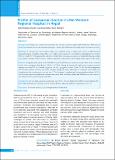Please use this identifier to cite or link to this item:
https://hdl.handle.net/20.500.14356/1605| Title: | Profile of Caesarean Section in Mid-Western Regional Hospital in Nepal |
| Authors: | Dhakal, Keshar Bahadur Dhakal, Sulochana Bhandari, Saroj |
| Citation: | DhakalK. B., DhakalS., & BhandariS. (2018). Profile of Caesarean Section in Mid-Western Regional Hospital in Nepal. Journal of Nepal Health Research Council, 16(1), 84-88. https://doi.org/10.33314/jnhrc.v16i1.1190 |
| Issue Date: | 2018 |
| Publisher: | Nepal Health Research Council |
| Article Type: | Original Article |
| Keywords: | Caesarean section(CS) CS complications CS indication |
| Series/Report no.: | Jan - Mar 2018;1190 |
| Abstract: | Abstract Background: Rising rate of caesarean section since few decades has been a global public health issue.This study is aimed to determine the rate of caesarean section plus examine the indications and complications of caesarean section. Methods: A retrospective cross-sectional study was conducted using secondary data sources at Mid-Western Regional Hospital in Surkhet, Nepal. Data were collected from patients’records ofthe hospital dating from 16 July 2016 to 15 July 2017. All patients who had delivered their baby by caesarean section were included in this study. Data were analyzed by help of SPSS version 21.Ethical approval was obtained from the hospital authority prior to the study. Results: During the study, out of total 3,694 deliveries, 695 (18.8%) were caesarean section. Most of the caesarean section were emergency than elective (83.0% vs 17.0%). Among all women who underwent caesarean section, majority were from 37 to 42 weeks pregnancy (88.5%), age group between 20 and 24 (42.9%) and multiparous (53.5%).Fetal distress (20.1%) was most common among all major indications of caesarean section.Maternal complications due to caesarean section was low (3.7%). Among all complications, Post-partum hemorrhage (30.5%) was the major maternal complication of caesarean section. Most of newborn babies had APGAR score six or more at one minute (94.5%) and five minutes (97.9%). Conclusions: In our study, caesarean section rate was 18.8%, which is higher than WHO recommendation (10 – 15%). Main indication for caesarean section was fetal distress. Maternal and fetal complications were low. |
| Description: | Original Article |
| URI: | http://103.69.126.140:8080/handle/20.500.14356/1605 |
| ISSN: | Print ISSN: 1727-5482; Online ISSN: 1999-6217 |
| Appears in Collections: | Vol. 16 No. 1 Issue 38 Jan-Mar 2018 |
Files in This Item:
| File | Description | Size | Format | |
|---|---|---|---|---|
| 1190-Manuscript-3933-2-10-20180314.pdf | Full text Article | 214.85 kB | Adobe PDF |  View/Open |
Items in DSpace are protected by copyright, with all rights reserved, unless otherwise indicated.
